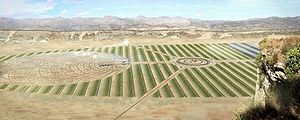
MICHAEL PAWLYN is a British architect with an affinity for the natural world.
So he is passionate about biomimicry—a discipline that looks at nature’s best ideas to inspire solutions to human problems. The Eden Project in Cornwall (pictured bottom), where Mr Pawlyn worked as a lead architect, is probably the best-known example of this approach. The pillowy and interlocking design of these biomes was influenced by dragonfly wings.
Since leaving Grimshaw, a British architecture firm, in 2007, Mr Pawlyn has concentrated exclusively on environmentally sustainable projects that are influenced by nature. One of his goals is to turn linear consumption models into cycles, whereby waste is used to fuel something else, much like the interdependency of ecosystems.
Having noticed that the boundaries of deserts shift over time, Mr Pawlyn’s latest scheme is to help reverse desertification in arid regions by growing vegetation. His Sahara Forest project (top) is an ambitious attempt to use concentrated solar power and seawater-cooled greenhouses to produce renewable energy, crops and water. Its success thus far has inspired new feasibility studies in Jordan and Qatar.
Earlier this autumn Mr Pawlyn published his first book, “Biomimicry in Architecture“. In a conversation with More Intelligent Life, he talks about his latest enterprises and his plans for the future.
Why were you drawn to biomimicry?
As a teenager I was torn between studying architecture and biology and eventually chose the former. I was also quite politicised about environmental issues in my early teens after a relative gave me a copy of the Club of Rome’s “Blueprint for Survival”. When I joined Grimshaw to work on the Eden Project I realised that there was a way to bring these strands together in pursuit of sustainable architecture inspired by nature.
You say we are entering the ecological age. What does that mean exactly?
As I see it, this is the age in which we have the knowledge, technology and imperative to formulate a truly sustainable way of living rather than pursuing approaches that simply mitigate negative impacts.
What are some of the most interesting examples, apart from the Eden Project, of existing architecture that uses biomimicry as its guiding principle?
Pier Luigi Nervi’s Palazzetto dello Sport, an indoor arena in Rome, is a masterpiece of efficiency inspired by giant Amazon water lilies. Many of Nervi’s projects were won in competitions and the secret to his success was his ability to produce the most cost-effective schemes. In a satisfying parallel with the refining process of evolution, the combination of ingenuity and biomimicry led to a remarkable efficiency of resources.
The Eastgate Centre in Harare, Zimbabwe, by Mick Pearce is based on termite mounds. It manages to create comfortable conditions for the people inside without air-conditioning in a tropical environment.
What species in nature are you most in awe of and why?
Camel’s nostrils are miracles of heat exchange and water recovery engineering. We are currently looking at cuttlebone and bird skulls to help design more efficient concrete structures for office buildings. The combustion chamber in the abdomen of a bombardier beetle mixes two high explosives from fuel tanks with valves that open and close 200 times a second—it is being studied in order to develop needle-free medical injections, more efficient fuel injection systems and more effective fire extinguishers.
Read more . . .
Bookmark this page for “biomimicry architecture” and check back regularly as these articles update on a very frequent basis. The view is set to “news”. Try clicking on “video” and “2” for more articles.








